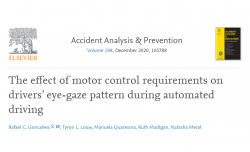New paper on drivers' eye movements in lane changes after automation
 A new paper, led by PhD researcher Rafael Cirino Gonçalves, was recently published in Accident Analysis & Prevention. The paper reports on a driving simulator study, originally conducted as part of the AdaptiVe project, which investigated how drivers’ eye movements and visual information acquisition strategies changed based on the level of vehicle automation intervention and on the motor-control aspects of a lane-change task. The researchers analysed drivers’ gaze fixations to the road centre and gaze dispersion in two different levels of automation (a fully automated and a partial automation system, requiring a transition of control) and a fully manual task.
A new paper, led by PhD researcher Rafael Cirino Gonçalves, was recently published in Accident Analysis & Prevention. The paper reports on a driving simulator study, originally conducted as part of the AdaptiVe project, which investigated how drivers’ eye movements and visual information acquisition strategies changed based on the level of vehicle automation intervention and on the motor-control aspects of a lane-change task. The researchers analysed drivers’ gaze fixations to the road centre and gaze dispersion in two different levels of automation (a fully automated and a partial automation system, requiring a transition of control) and a fully manual task.
The results of the study showed a significant decrease in drivers’ visual attention to the road centre with lower levels of manual engagement with the driving task, however, as drivers began executing the lane-change manoeuvre, the pattern of their eye movements converged, regardless of whether drivers were responsible for the manual control of the lane change. However, there was one notable difference when drivers were resuming control from automation: their eye gaze was significantly more dispersion towards the instrument cluster right after disengaging automation, probably to check the current status of the system.
This result is in line with findings in past literature that the absence of motor control of a vehicle increases eye gaze dispersion, however, this study highlights the importance of strategic-related information inherent to a lane change task, that was able to shape a common pattern among the experimental conditions, regardless the need of manual intervention. Another relevant output of the paper was the evident need for drivers to check the system status information right after a transition of control from vehicle automation.
The full text is available here
Goncalves, R. C., Louw, T. L., Quaresma, M., Madigan, R., & Merat, N. (2020). The effect of motor control requirements on drivers’ eye-gaze pattern during automated driving. Accident Analysis & Prevention, 148, 105788.
